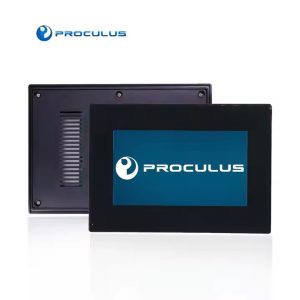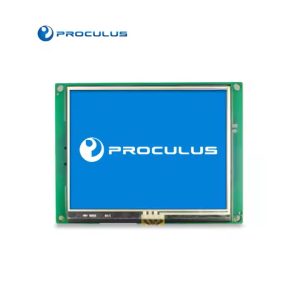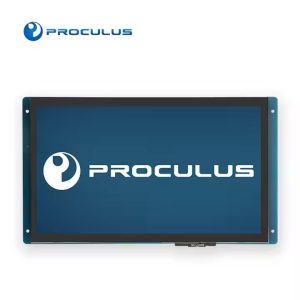Custom TFT display: Why and how to customize
A custom TFT display i a strategic design choice. When your project demands more than what off-the-shelf solutions can offer, customization opens the door to smarter integration, better performance, and a user experience that feels just right.
Whether you’re building a medical device, an industrial control panel, or a next-gen consumer product, tailoring your display can be the edge that sets your solution apart.
 Customizing a TFT display is a strategic process that aligns hardware, software, and interface requirements to the specific needs of your product.
Whether you’re building a medical device, industrial controller, or smart home application, the goal is to optimize the display experience while ensuring seamless integration into your system architecture. Here’s how to do it:
Customizing a TFT display is a strategic process that aligns hardware, software, and interface requirements to the specific needs of your product.
Whether you’re building a medical device, industrial controller, or smart home application, the goal is to optimize the display experience while ensuring seamless integration into your system architecture. Here’s how to do it:
What is a custom TFT display?
A custom TFT (Thin-Film Transistor) display is a tailor-made LCD solution specifically designed to meet the exact needs of a particular application. Unlike standard modules, which follow fixed formats in terms of size, interface, brightness, and layout, custom TFT displays can be configured across multiple layers — from physical dimensions and touchscreen type to firmware behavior and display protocol. Customization can include:- Specific screen sizes or aspect ratios
- Unique mounting or housing designs
- Capacitive or resistive touch integration
- Interface options (UART, SPI, HDMI, etc.)
- Pre-programmed UI layouts or firmware features
What is the difference between a standard and a custom TFT display?
The key difference lies in flexibility and optimization. A standard TFT display is mass-produced, widely available, and generally suited for basic or general-purpose applications. It offers faster lead times and lower cost in low-risk or hobbyist contexts, but may require compromises in design fit, performance, or software compatibility. In contrast, a custom TFT display is engineered specifically for your product:- Mechanical Fit: It aligns perfectly with your device’s enclosure, reducing need for adapters or redesign.
- Functionality: You can add or remove features — like specific touch layers, brightness levels, or connectors — based on operational needs.
- Software Integration: The display firmware, drivers, and GUI can be optimized for your hardware and operating environment.
- Brand Consistency: Custom visuals and UI elements reinforce your brand identity through a cohesive, purpose-built interface.
Why customize a TFT display?
Customizing a TFT display enables developers and engineers to design smarter, more efficient, and more competitive products. Here’s why customization makes a significant difference:- Optimized User Experience: With full control over size, resolution, brightness, and input, you can build a display that works exactly as users expect — with no distractions or limitations.
- Reduced Engineering Overhead: A custom-fit display reduces the need for hardware modifications, saves board space, and minimizes software workarounds. Product Differentiation: In saturated markets, a unique user interface powered by a custom display can be a key selling point — especially in consumer and medical devices.
- Environmental Performance: Need a display that performs under sunlight, moisture, or industrial temperatures? Customization allows you to select components designed for these exact conditions.
- Lifecycle Control: With a custom display, you’re less dependent on third-party component obsolescence and can secure long-term availability that aligns with your product roadmap.
- Efficient Integration: With pre-integrated communication protocols (like UART), a display module can plug directly into your system, reducing development time and lowering costs.
How to customize the TFT display for your project?
 Customizing a TFT display is a strategic process that aligns hardware, software, and interface requirements to the specific needs of your product.
Whether you’re building a medical device, industrial controller, or smart home application, the goal is to optimize the display experience while ensuring seamless integration into your system architecture. Here’s how to do it:
Customizing a TFT display is a strategic process that aligns hardware, software, and interface requirements to the specific needs of your product.
Whether you’re building a medical device, industrial controller, or smart home application, the goal is to optimize the display experience while ensuring seamless integration into your system architecture. Here’s how to do it:
Define your project requirements
Start by outlining the functional and environmental needs of your application. Consider:- Display size and resolution based on available space and information density.
- Touch technology: Capacitive for smooth, modern UIs or resistive for glove/fingerprint-friendly industrial use.
- Brightness and contrast levels depending on indoor/outdoor usage.
- Temperature range, ingress protection (IP rating), and certification needs for demanding environments.
- Interface requirements, such as UART, SPI, or HDMI, to match your system’s capabilities.
Customize the display module
Next, adapt the physical and electrical characteristics of the module:- Panel size and shape (landscape, portrait, custom aspect ratios).
- Touch panel selection and bonding method.
- Cover lens customization, including logo printing, anti-glare coatings, or custom cutouts.
- Connector and pin configuration tailored to your assembly process.
- Backlight tuning to balance power consumption and visibility.
Customizing the firmware & drivers
Firmware customization ensures your display communicates effectively with the rest of your system. Depending on your platform, this can involve:- Modifying boot-up behavior, startup screens, or display timing.
- Customizing UART protocols or command sets for smoother integration.
- Optimizing memory management and refresh sequences for responsive interfaces.
- Ensuring compatibility with operating system drivers, or supporting bare-metal environments with custom APIs.
Custom PCB & FPC cable design
To fit the display module into your product, the PCB layout and connection interfaces often need to be adapted:- Custom PCBsmay be designed to include touch controllers, power management, or additional I/O.
- Flexible Printed Cable (FPC) layouts can be adjusted for length, shape, and pin mapping to match your enclosure and assembly method.
- Careful attention to EMC performance, signal integrity, and thermal management is also key at this stage.
Software & driver integration
With hardware and firmware in place, the next step is interface development. Proculus’ UnicView Studio allows you to:- Design professional GUI layouts visually — no advanced coding required.
- Use built-in widgets, animations, and logic to create interactive screens.
- Simulate and test interactions before flashing the display.
- Easily integrate with your MCU via simple UART commands.
Testing & validation
Before mass production, the customized display system should undergo thorough validation:- Functional testing ensures display, touch, and interface logic perform as expected.
- Environmental tests verify operation under temperature, humidity, and vibration extremes.
- EMC and regulatory compliance checks confirm the solution meets necessary standards.
- Aging and durability tests simulate long-term use and help preempt issues in the field.
How can UART TFT LCD Display Module help your project?
The Proculus UART TFT LCD Display Module is designed specifically to make customization easier, faster, and more accessible. Its key benefits include:- Simple UART communication, compatible with virtually any MCU or embedded system.
- A powerful and intuitive UnicView Studio GUI development platform.
- Modular hardware options with various display sizes, resolutions, and touch types.
- Built-in storage, logic processing, and user interface control — offloading your main processor.
- Full support for custom firmware and flexible interfaces.
Conclusion
A customized TFT display isn’t just a visual component — it’s a critical part of the user experience and system design. By carefully aligning the physical, electrical, and software elements of your display, you can deliver a solution that’s reliable, high-performance, and uniquely tailored to your product. With Proculus’ UART TFT LCD Modules and engineering support, turning your custom display vision into reality is both efficient and scalable. For more insights and technical tips, explore our blog.
Category:
Author:
Client:
Date:
PHP Code Snippets Powered By : XYZScripts.com
 English
English


